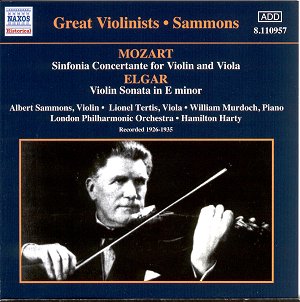Old recordings of Mozart can surprise in a number
of ways. They can sometimes be surprisingly brisk and clean, seemingly
anticipating much more modern trends. Or they can sometimes be
swoony, sticky and of value only as an uncomfortable reminder
of how our grandfathers saw this music. The present, first ever,
recording of the Sinfonia Concertante manages to be both these
things!
Sir Hamilton Harty expounds the exposition to
the first movement at an ideal tempo, relaxed yet vital, with
very clear textures and, apart from the presence of a few slides
from the violins (this was Beecham’s orchestra and in his own
Mozart recordings with it he was surprisingly tolerant of slides),
it could have been conducted yesterday. Then the soloists enter
… The general rule seems to be that, whatever tempo the orchestra
is playing at, the soloists have to change it when they come in,
to disconcertingly rhapsodic effect. And then, they seem to be
having a competition to see who can make the most portamentos.
Their entries in the development section are positively drooled
over. And as for the cadenza! They start off innocently enough
using Mozart’s own material, but then proceed with one written
by Tertis (based on one by Hellmesberger), the model for which
seems to have been the Widor Toccata.
In the second movement it’s Harty’s turn to get
things wrong, setting a too swift minuet-like tempo which the
soloists have to adjust. Thereafter there is much warmth albeit
of a not very Mozartian kind, but even in 1933 such a miscalculation
might have warranted a retake. Due to lack of space (I presume)
the cadenza has been cut, thereby sparing us another Tertis-Hellmesberger
monstrosity. Probably the finale is the most satisfactory, the
soloists for once content to go along with Harty’s well-judged
tempo. Not much more than a curio, this performance, but did Harty
record any of the Mozart Symphonies?
The Nachez is impressive, prompting the unkind
thought that violinists of this epoch were better heard in minor
trinkets of the kind. Unfortunately the
piece lasts 7’37” and outstays its welcome. Both Sammons and that
usually supreme Schubertian Gerald Moore are heavy-handed in the
Rosamunde Entr’acte, and the Massenet is a little too forward-moving
to reveal all its fragrant charms. The Dvořák is neatly
turned, but comparison with Kreisler shows what is missing. Kreisler
may seem over-indulgent with his slides and his rubato, but once
heard his version is hard to forget, for his violin takes on a
vocal quality which justifies everything he does. And incidentally,
his arrangement sticks imperturbably to Dvořák’s original
“unviolinistic” key of G flat while the Rehfeld arrangement used
by Sammons is transposed into G. Not much justification for calling
Sammons “the English Kreisler” on the strength of this,
and the same can be said for the Londonderry Air with which Sammons
seems strangely impatient, unwilling to let it breathe. Again,
Kreisler’s violin has a vocal quality which lifts it onto another
plane. Both violinists play their own arrangements. Sammons’s
is notably for some weird chromatic harmonies, suggestive of a
heavy-handed parody of Cyril Scott and singularly inappropriate
to the task in hand. Kreisler starts more simply but then he gets
an attack of post-impressionism too. One wonders if both gentlemen
had intended their arrangements as entries to some long-forgotten
bad taste competition.
I should be presumptuous to take issue with Sammons’s
playing of his own pretty little Bourrée and it is in fact
charming.
Which leaves the Elgar.
Everything I have written above really ignores
the fact that Albert Sammons was a superb musician and a dedicated
artist. He did much for the music of his native country, frequently
performing the Elgar concerto with the composer and making (with
Sir Henry Wood) the first complete recording, one which some feel
has not been surpassed. He gave the first performances of the
concertos by Delius (the Elgar and Delius are coupled together
on another Naxos CD), Dyson and Moeran (a recording of the latter
has survived on Symposium) as well as numerous chamber works.
The problem is that he was British, and also disinclined towards
foreign travel, with the result that, while he could have surely
left us fine recordings of Brahms, Bruch and the romantic repertoire
generally, so far as I am aware he was not asked to do so. He
was not the first interpreter of the Elgar Sonata (that was Will
Reed) but he quickly took it up and this recording, with his regular
duo partner William Murdoch, is a worthy companion to the Concerto,
strong and ardent in the big moments, wistful and poetic in the
central movement. The only problem is that while the violin sound,
here and throughout the disc, comes across remarkably well, it
is very close up with the piano a long way behind. So if you want
to sit back and enjoy the work, rather than make a study of an
authentic interpretation, you will need a more modern version.
Perhaps because of this imbalance, I have to say that ultimately
Sammons and Murdoch are no more able than anyone else to persuade
me that characteristic Elgarian inspiration is in pretty short
supply in this rather dry product of his later years. I know that
people who say things like this can expect a flood of hate-mail
from True British Music Lovers, but there it is.
Specialists will only need to know that the transfers
produce natural and convincing sound. Aspiring performers of the
Elgar should certainly hear this. As for the general listener,
well, if you haven’t got the Elgar/Delius coupling, get that first.
Christopher Howell

